Bristol
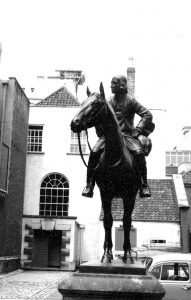
John Wesley statue, Broadmead
Served by several motorways and linked to Wales by two vast suspension bridges, Bristol is the unofficial capital of the west of England. Before the Industrial Revolution it was the largest city in England after London. Connected to the sea via the River Avon, it was once an important port and in the eighteenth century grew rich on the profits of the Slave Trade. In Victorian times, the tracks and yards of Brunel's celebrated Great Western Railway carved great swathes through the city. During the Second World War, Hitler's bombs did their worst and post-war planners bulldozed much of what was left. However, pockets of the medieval city survive, and elegant Georgian terraces can be seen in several areas.
Many famous Christians have lived in Bristol, and many great movements began or flourished here. John Wesley and George Whitefield began their open-air ministries by preaching to the miners of Kingswood, and the New Room in Broadmead was built to serve the needs of the growing Methodist societies. The writer and educationalist Hannah More was born and died in the city. She ran a successful school in Park Street near the Cathedral before starting her mission to the impoverished children of Somerset, while her contemporary Thomas Clarkson scoured the docks and pubs around Marsh Street and King Street, gathering evidence against the evils of the slave trade, which he fed to William Wilberforce and other abolitionists. In the Victorian era, George Muller began his mission of mercy among Bristol's orphans in Wilson Street, close to the city centre. When he died, 2,000 children were being cared for in five enormous homes on Ashley Down.
BROADMEAD

New Room pulpit
We shall begin - more or less - in the centre. Sandwiched between Horsefair and the pedestrianised Broadmead is the New Room, officially No 36 Horsefair (BS1 3JE). The name is inappropriate, since it is actually the oldest Methodist building in the world, dating from the start of the movement in 1739, with major extensions added in 1748. The word "room" hardly does justice to the beauty and symmetry of the chapel, but at the time the Methodist societies were firmly within the Anglican fold and there was no thought of starting a new denomination.
From the Broadmead side we come into a cobbled courtyard, with an equestrian statue of John Wesley, book in hand, by Gordon Walker. There is also a Preachers Stable, the eighteenth century equivalent of a reserved parking space, complete with saddles, stalls and a bale of straw! The dignity and simplicity of the chapel has been admired by many, including John Betjeman, who with equal vehemence deplored the Broadmead shopping centre in which it stands. The roof is supported by six stone columns and there are galleries on three sides. The pulpit has upper and lower lecterns, for the preacher and clerk respectively.
Inside, we can enjoy the calm and tranquility of the building, but it was not always so. Due to possible attacks by the mob, the chapel was built without windows below the gallery and there are no stairs to the pulpit from below. A staircase from the pulpit to the preachers' rooms above provided an escape route if the speaker was threatened with violence. Light from the octagonal lantern in the centre helps to compensate for the lack of windows. In the vestry are prints of famous events from the life of Wesley and around the walls wooden panels describe significant milestones in the history of Methodism. Some of these sketch the lives of other famous Methodists, including the saintly John Fletcher and two who pioneered the growth of the movement in America, Francis Asbury and Thomas Coke.
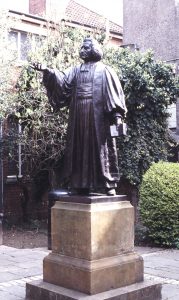
Charles Wesley's statue
Above the chapel is the common room where John Wesley taught his preachers and shared their meals. Leading off are several bedrooms named after the Wesleys and other pioneers like Fletcher, Asbury and Adam Clarke. Charles Wesley lived here for a year prior to his marriage and the rooms now form a museum with original portraits of the Wesley family, letters, furniture and other Methodist memorabilia.
On the Horsefair side is another courtyard, planted with flowers and shrubs. The statue here is of Charles Wesley, who initially opposed the building of the New Room but went on to lead the Methodist societies in Bristol. He is shown in preaching stance, with the inscription O let me commend my Saviour to you.
In Penn Street, a continuation of Horsefair, there was once a Tabernacle built for George Whitefield in 1753 but now demolished. Whitefield and Wesley had worked together, and honoured each others labours, but theological differences meant their careers took different paths and their followers often had separate chapels. The only reminder of Whitefield's time here is George Whitefield Court, a short alley backing on to busy Bond Street.
The name Penn Street suggests a Quaker connection and sure enough it leads into a secluded square called Quaker Friars, where monastic buildings dating from 1227, once the property of the Dominican Friars, were used by the Quakers from 1670. In 1747, a Quaker Meeting House was built onto the east end of the complex, and the whole building is now used as the Bristol Register Office. Both George Fox, the founder of the Quakers, and William Penn, the founder of Pennsylvania, were regular visitors.
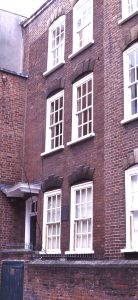
Charles Wesley's house
Following his marriage to Sarah Gwynne, Charles Wesley and his family spent 22 years in Bristol. Their home was at 4 Charles Street (BS2 8NY) a short walk from Horsefair. The three-storey house with its immediate neighbour now stands rather forlornly - an eighteenth century remnant in an area of twenty-first century office blocks and traffic systems. He is said to have composed many of his 6,000 verses here. Still owned by the Methodists, the house carries a memorial plaque, but can only be visited by appointment.
It was in Dighton Street, running parallel to Charles Street, that John Wesley ordained Thomas Coke as General Superintendent of Methodists in America on September 2nd 1784. This event was significant not only for the history of the church in America. It was also the first occasion that Wesley, so long a loyal Anglican, had ordained his own clergy, thus making a formal break with the rubrics of the Church of England. The decision to ordain Coke was bitterly opposed by Charles.
There is a poignant reminder of Charles Wesley's time in Bristol at St James Priory Church, just across the Haymarket from Horsefair (BS1 3NZ). As a lifelong loyal Anglican, this was his parish church and that of the Horsefair society, which he led. This was where his children were baptized and also where five of them are buried. A stone in the churchyard commemorates the deaths in infancy of John, Martha Maria, Susannah, Selena and John James.
The Priory Church claims to be the oldest building in Bristol with parts dating back to its foundation in 1129. From 1799 until his death in 1838, the vicar was Thomas Biddulph, one of the next generation of evangelical leaders and a founder of the Church Missionary Society. There is a marble bust of Biddulph in the south aisle, recording that he performed his pastoral duties with "zeal, faithfulness and ability".
COLLEGE GREEN
The area has links with the writer and social reformer Hannah More (1745-1833), who was born at Stapleton in the Fishponds district. She was a precocious child and learned classics, maths and languages from her father, the master of the local free school. With her sisters, she started a private school for girls in Trinity Street just behind the Cathedral. Its success prompted a move to a house in Park Street, whose elegant Georgian terraces lead up from College Green to the University. There used to be a plaque on number 43, marking the site of the school.
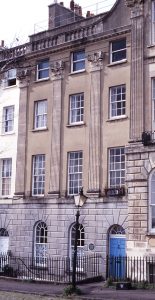
Hannah More's house
In the nearby Georgian House Museum (BS1 5RR) in Great George Street there is a portrait of Hannah More painted by the sister of Sir Joshua Reynolds. Great George Street was was also the location of the Bethesda Chapel, an early Brethren congregation led by George Muller and Henry Craik. It was destroyed during a bombing raid in 1941.
In 1774 Hannah More visited London and became friends with Edmund Burke, David Garrick and Samuel Johnson, but under the influence of evangelical friends like John Newton and William Wilberforce, she felt the call to dedicate her life to educational work among the poor of Somerset. We tell her story in more detail at Cheddar and Wrington, where she is buried. In 1828, her health failed and her final years were spent at 4 Windsor Terrace, Clifton, an elegant five-storey Georgian house set high above the Avon gorge (BS8 4LW). To find it, the complex Hotwells Road traffic system must be negotiated, but the view across the river to Bedminster and beyond is impressive.
Park Street leads into Queens Road where the City Museum and Art Gallery is located, close to the University (BS8 1RL). Amongst other treasures, it has the famous portrait of Martin Luther by his friend Lucas Cranach the Elder.
GEORGE MULLER and his homes
In the St Paul's district (BS2 8SJ), today often stigmatised as a run down "inner city" area, is Wilson Street. It was here in 1836 that George Muller (1805-1898) began a home for children orphaned by an outbreak of cholera. It was here too that he learned lessons of faith and prayer that would stand him in good stead all his life. One day with no food on the table and no money to buy any, he led his family in prayers for their "daily bread". They were answered convincingly when a milk cart broke down nearby and needed to offload its cargo, while a local baker, unable to sleep, got up at midnight to do some baking and arrived with a supply of fresh loaves. Muller's faith grew with practice and within a few years four houses in the street were being used to shelter the orphans under his care. Today the houses are covered with unattractive cement rendering, but the doors have unusual fluted doorposts and arches which look original. There are no plaques to identify the houses used by Muller.
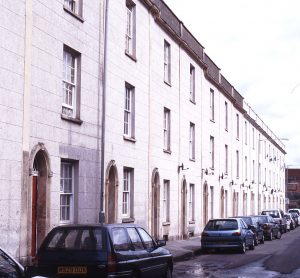
Wilson Street
Born in Kroppenstadt, Prussia, Muller came to England intending to train as a missionary to the Jews. A change of plans led him to spend some time as pastor of a church in Teignmouth, Devon. He became involved with the early leaders of the Brethren movement and in 1830 married Mary Groves, sister of A. N. Groves, another of the leaders. While pursuing his work with orphans, he led the fellowship at Bethesda Chapel, together with Henry Craik. Another branch of the movement flourished in Plymouth, resulting in the more familiar name of Plymouth Brethren.
In 1845, Muller decided that a move from the foetid and overcrowded centre of Bristol was essential. Land was purchased at Ashley Down on the north side of the city - higher, healthier and with much more space (BS7 9BU). Between 1849 and 1870, five vast orphan houses were built which eventually accommodated over 2,000 children. In recent years the buildings, adjacent to the Gloucester county cricket ground, have undergone extensive redevelopment. Some form part of the City of Bristol College, while others are being modified for residential use. Looking at the site, one can only gasp at the depths of Muller's faith. The homes were paid for entirely by unsolicited donations from his supporters. The George Muller Museum at 45-47 College Road (BS7 9FG) tells the full story of Muller's homes, caring for over 10,000 children during his lifetime (See www.mullers.org/museum) .
After forty years of marriage, Mary Muller died in 1870 and a year later Muller married Susannah Sangar, whom he also outlived. At the age of 70, he embarked on a series of preaching journeys, which, with brief interludes, lasted for the next seventeen years. Making full use of improved transport in the late nineteenth century, he visited almost every country in Europe, and much of the Middle East, North America, India, China, Japan and Australia.
Muller's death at the age of 92 was marked by deep mourning throughout Bristol. He is buried beside his two wives in the Arno's Vale cemetery on the Bath Road (BS4 3EW). It covers a vast area and, when we visited, the elaborate memorials were overgrown and neglected. There were plans to restore it as the cemetery for Bristol's history, architecture, landscape and wildlife, and the project may now be near completion. The website above gives directions to Muller's grave.
HANHAM MOUNT
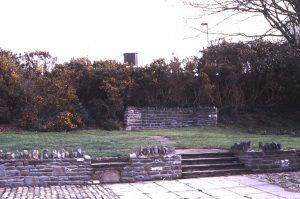
Hanham Mount
Hanham lies about four miles east of the city centre on the A431 towards Bath. It is an uninspiring suburb, but a place rich in memories. It was here that George Whitefiled and later John Wesley first took to the open air, when they stood up to preach to the colliers of Kingswood. Whitefield described the results: The first discovery of their being affected was to see the white gutters made by their tears which plentifully fell down their black cheeks, as they came out of their coal pits. The evangelical revival had begun.
The scene of these events is marked by a beacon and memorial in Mount Hill Road (BS15 9SZ). In front is a grassy area with a large paved cross, beyond which a gorse-covered bank leads up to a stone platform with a wooden replica of John Wesley's pulpit. It appears to be inviting visitors to try their hand at impromptu open air sermons! Set into the ground is Wesley's famous dictum All the world is my parish. Nearby the tall beacon reminds us that a light set on a hill cannot be hid. The location resembles a natural amphitheatre and, if the eighteenth century topography was similar, it was a well-chosen spot for outdoor preaching.
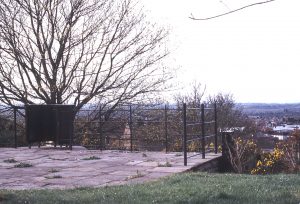
Wesley'spulp[it, Hanham Mount
As the plaque records, Whitefield and Wesley were not the first to use this spot for open air worship. From 1658 to 1684 the woods covering the hill were a meeting place for Baptists, at a time when non-conformist meetings were forbidden or severely restricted. To reach the place, preachers would sometimes risk life and liberty by swimming the flooded River Avon at Conham to bring the gospel to the Kingswood colliers.
KINGSWOOD
Just north of Hanham is Kingswood, where in 1748 John Wesley founded a school for the sons of the converted colliers, many of whom became itinerant preachers. The first headmaster was one of Wesley's fellow preachers, John Cennick. The administration and funding of the school became a considerable burden in subsequent years, and Wesley makes frequent references to its problems in his diary. However, it survived and became the forerunner of Methodist education all over the world. Even Nelson Mandela attended a Wesleyan College in South Africa! The school continued at Kingswood until 1852, when it removed to a new site in Bath, where it continues as an independent Methodist school. The Kingswood buildings, in Britannia Road, were put to other uses and now form part of the John Cabot City Technology College.


